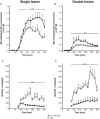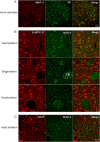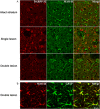Increased L-DOPA-derived dopamine following selective MAO-A or -B inhibition in rat striatum depleted of dopaminergic and serotonergic innervation
- PMID: 23992249
- PMCID: PMC3949649
- DOI: 10.1111/bph.12349
Increased L-DOPA-derived dopamine following selective MAO-A or -B inhibition in rat striatum depleted of dopaminergic and serotonergic innervation
Abstract
Background and purpose: Selective MAO type B (MAO-B) inhibitors are effective in potentiation of the clinical effect of L-DOPA in Parkinson's disease, but dopamine (DA) is deaminated mainly by MAO type A (MAO-A) in rat brain. We sought to clarify the roles of MAO-A and MAO-B in deamination of DA formed from exogenous L-DOPA in rat striatum depleted of dopaminergic, or both dopaminergic and serotonergic innervations. We also studied the effect of organic cation transporter-3 (OCT-3) inhibition by decinium-22 on extracellular DA levels following L-DOPA.
Experimental approach: Striatal dopaminergic and/or serotonergic neuronal innervations were lesioned by 6-hydroxydopamine or 5,7-dihydroxytryptamine respectively. Microdialysate DA levels after systemic L-DOPA were measured after inhibition of MAO-A or MAO-B by clorgyline or rasagiline respectively. MAO subtype localization in the striatum was determined by immunofluorescence.
Key results: Rasagiline increased DA extracellular levels following L-DOPA to a greater extent in double- than in single-lesioned rats (2.8- and 1.8-fold increase, respectively, relative to saline treatment); however, clorgyline elevated DA levels in both models over 10-fold. MAO-A was strongly expressed in medium spiny neurons (MSNs) in intact and lesioned striata, while MAO-B was localized in glia and to a small extent in MSNs. Inhibition of OCT-3 increased DA levels in the double- more than the single-lesion animals.
Conclusions and implications: In striatum devoid of dopaminergic and serotonergic inputs, most deamination of L-DOPA-derived DA is mediated by MAO-A in MSN and a smaller amount by MAO-B in both MSN and glia. OCT-3 plays a significant role in uptake of DA from extracellular space. Inhibitors of OCT-3 are potential future targets for anti-Parkinsonian treatments.
Keywords: 6-hydroxydopamine; L-DOPA; OCT-3; Parkinson's disease; clorgyline; glial cells; medium spiny neurons; microdialysis; rasagiline.
© 2013 The British Pharmacological Society.
Figures







Similar articles
-
In vivo comparison of the effects of inhibition of MAO-A versus MAO-B on striatal L-DOPA and dopamine metabolism.J Neural Transm Park Dis Dement Sect. 1995;10(2-3):79-89. doi: 10.1007/BF02251224. J Neural Transm Park Dis Dement Sect. 1995. PMID: 9620056
-
Selective inhibition of monoamine oxidase A or B reduces striatal oxidative stress in rats with partial depletion of the nigro-striatal dopaminergic pathway.Neuropharmacology. 2013 Feb;65:48-57. doi: 10.1016/j.neuropharm.2012.08.023. Epub 2012 Sep 7. Neuropharmacology. 2013. PMID: 22982254
-
L-3,4-dihydroxyphenylalanine-induced dopamine release in the striatum of intact and 6-hydroxydopamine-treated rats: differential effects of monoamine oxidase A and B inhibitors.J Neurochem. 1994 Jul;63(1):108-17. doi: 10.1046/j.1471-4159.1994.63010108.x. J Neurochem. 1994. PMID: 8207420
-
Multisite intracerebral microdialysis to study the mechanism of L-DOPA induced dopamine and serotonin release in the parkinsonian brain.ACS Chem Neurosci. 2013 May 15;4(5):680-92. doi: 10.1021/cn400046e. Epub 2013 Apr 15. ACS Chem Neurosci. 2013. PMID: 23541043 Free PMC article. Review.
-
L-DOPA and serotonergic neurons: functional implication and therapeutic perspectives in Parkinson's disease.Cent Nerv Syst Agents Med Chem. 2011 Dec 1;11(4):305-20. doi: 10.2174/1871524911106040305. Cent Nerv Syst Agents Med Chem. 2011. PMID: 22117594 Review.
Cited by
-
Quinine enhances the behavioral stimulant effect of cocaine in mice.Pharmacol Biochem Behav. 2015 Feb;129:26-33. doi: 10.1016/j.pbb.2014.11.021. Epub 2014 Dec 5. Pharmacol Biochem Behav. 2015. PMID: 25482328 Free PMC article.
-
What Mechanisms Are Responsible for the Reuptake of Levodopa-Derived Dopamine in Parkinsonian Striatum?Front Neurosci. 2016 Dec 15;10:575. doi: 10.3389/fnins.2016.00575. eCollection 2016. Front Neurosci. 2016. PMID: 28018168 Free PMC article. Review.
-
Pb exposure prolongs the time period for postnatal transient uptake of 5-HT by murine LSO neurons.Neurotoxicology. 2016 Dec;57:258-269. doi: 10.1016/j.neuro.2016.10.010. Epub 2016 Oct 19. Neurotoxicology. 2016. PMID: 27771255 Free PMC article.
-
Inhibitors of MAO-B and COMT: their effects on brain dopamine levels and uses in Parkinson's disease.J Neural Transm (Vienna). 2019 Apr;126(4):433-448. doi: 10.1007/s00702-018-1952-7. Epub 2018 Nov 1. J Neural Transm (Vienna). 2019. PMID: 30386930 Review.
-
Deuterium-substituted L-DOPA displays increased behavioral potency and dopamine output in an animal model of Parkinson's disease: comparison with the effects produced by L-DOPA and an MAO-B inhibitor.J Neural Transm (Vienna). 2015 Feb;122(2):259-72. doi: 10.1007/s00702-014-1247-6. Epub 2014 Jun 7. J Neural Transm (Vienna). 2015. PMID: 24906468
References
-
- Arai R, Horiike K, Hasegawa Y. Dopamine-degrading activity of monoamine oxidase is not detected by histochemistry in neurons of the substantia nigra pars compacta of the rat. Brain Res. 1998;812:275–278. - PubMed
-
- Butcher SP, Fairbrother IS, Kelly JS, Arbuthnott GW. Effects of selective monoamine oxidase inhibitors on the in vivo release and metabolism of dopamine in the rat striatum. J Neurochem. 1990;55:981–988. - PubMed
-
- Carlsson A, Fowler CJ, Magnusson T, Oreland L, Wiberg A. The activities of monoamine oxidase-A and-B, succinate dehydrogenase and acid phosphatase in the rat brain after hemitransection. Naunyn Schmiedebergs Arch Pharmacol. 1981;316:51–55. - PubMed
-
- Carta M, Carlsson T, Kirik D, Bjorklund A. Dopamine released from 5-HT terminals is the cause of L-DOPA-induced dyskinesia in Parkinsonian rats. Brain. 2007;130(Pt 7):1819–1833. - PubMed
Publication types
MeSH terms
Substances
LinkOut - more resources
Full Text Sources
Other Literature Sources
Research Materials
Miscellaneous

